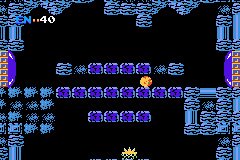An Ode to Metroid's Morph Ball
Christian Haines, Managing Editor
Metroid has become shorthand for a specific kind of level design in video games. Whereas The Legend of Zelda (1986) laid the foundations for open-world adventures, Metroid (also 1986) offered a more claustrophobic version of world-building and exploration. Metroid may have ditched the linear design of Super Mario Bros. in favor of branching paths and backtracking, but, in keeping the 2D profile perspective, it maintained a cramped environment, a sense of tight enclosure. In 1986, the planet Zebes was a vast labyrinth, but its walls, floors, and ceilings never stop pressing down on you, its obstacles never cease interrupting your momentum. Galloping across Hyrule Field in Ocarina of Time is peak Zelda, as is paragliding off the Great Plateau in Breath of the Wild. In both cases, Link’s simulated momentum speaks to the vastness of the world lying ahead of the player. In contrast, the environments and gameplay of the Metroid series – the recent Metroid Dread included – make you feel like the walls might cave in on you at any moment. Dread, indeed.
Courtesy of the Metroid Wiki.
Samus’s Morph Ball ability isn’t just emblematic of Metroid’s cramped exploration, it’s one of its basic building blocks. It seals the bond between Samus and her environment, acknowledging that virtual density isn’t just a property of the series’ monster-infested planets but of the famed bounty hunter herself. How does Samus squeeze herself into a tight metal sphere? Does she break thermodynamic principles in shrinking to a fraction of her former self? Is some kind of quantum shift involved, some sci-fi dimension shifting? The manual for the original game describes the morph ball with the Japanese phrase Maru Mari, which translates into English as “to roll into a ball.” Explanations of how the morph ball works are beside the point, at least in terms of level design. What matters is the ability’s function and feel: to advance through the game, you must contract – you must roll into a ball, shrink, minimize your avatar into a form capable of squeezing through crevices, rolling back and forth through the narrowest tunnels.
Courtesy of the Metroid Wiki.
Praise to the morph ball! It reverses Mario’s mushroom-fueled growth; it resurrects one of the earliest video game elements – the bouncing ball of Atari’s Pong – only to free it from the single-screen boundaries of the virtual tennis court. The morph ball anticipates the vulnerability of survival horror games, like the Resident Evil series or Silent Hill, in the way it sends the player down cramped corridors that make them incredibly vulnerable to enemies. I wouldn’t classify the Metroid series as survival horror, but it does share with that genre an insistence on reminding the player that Samus is mortal, that whatever amount of alien matter might splice get spliced into her genes, the game only works if she’s always on the verge of death.
Courtesy of the Metroid Wiki.
Metroid is at its most Metroid not when Samus is blasting enemies away with super missiles, but when she’s squeezing down tunnels in morph ball form, an alien planet threatening to crush her and her suit like a used tin can. This is why so many of the games in the series end with escape sequences, a clock counting down as the player struggles to platform out of harm’s way: you may have acquired all the abilities, all the energy and missile tanks, but, as powerful as she’s become, Samus is still flesh and blood enclosed by a strange planet, drifting through the cold, dark void of outer space.
For more Metroid musings, listen to the Episode 1 of Retronomicon, where we discuss the Metroid series, and read Nate Schmidt on the EMMI in Metroid: Dread.





